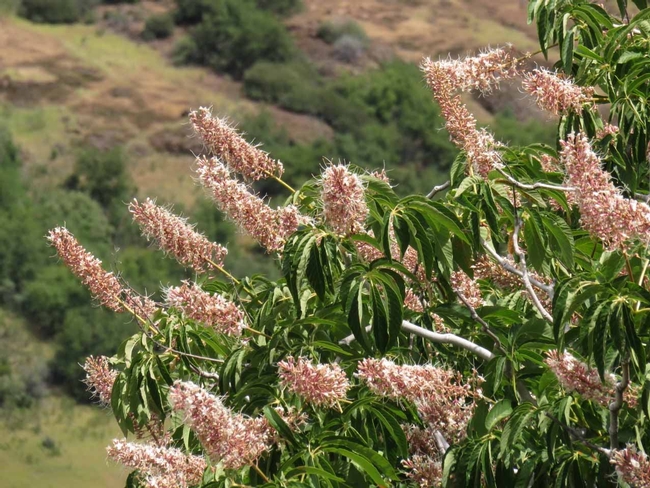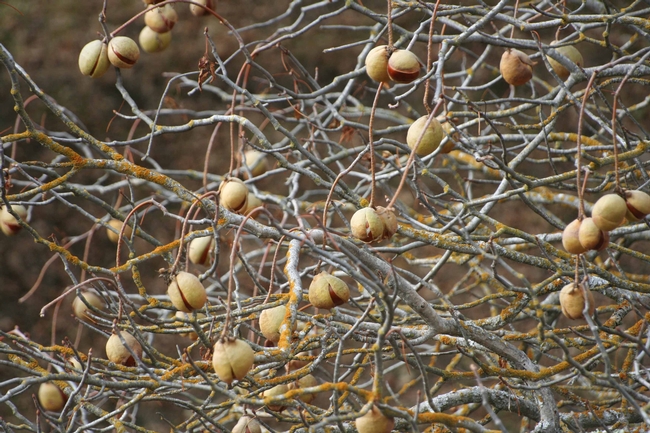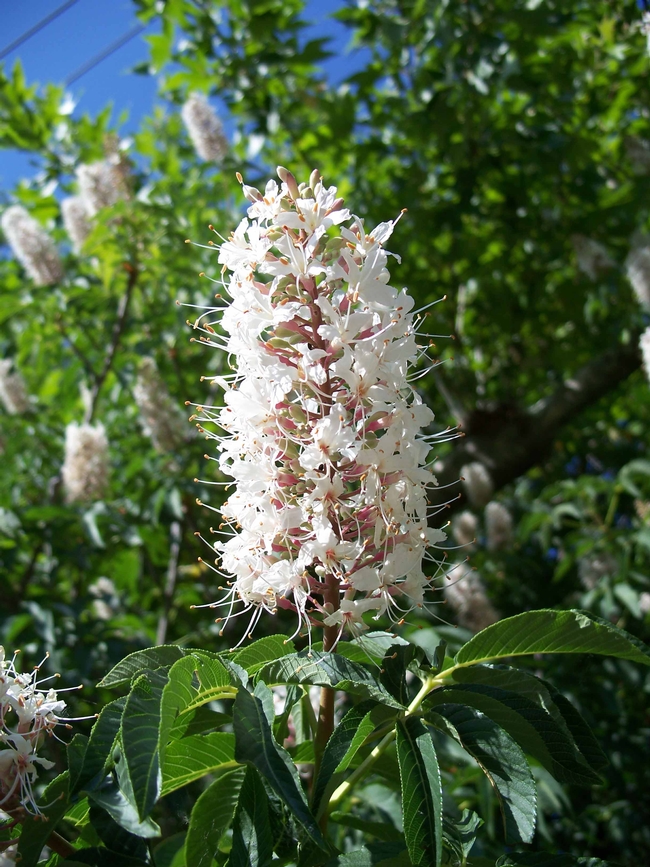Finding an Ecological Niche: A Three-Part Series on Selected Foothill Woodland and Chaparral Species, Part 3 of 3: The Buckeye
By Laura Lukes, UC Master Gardener of Butte County, March 22, 2019
[Note: Buckeye (Aesculus californica), gray pine (Pinus sabiniana), and blue oak (Quercus douglasii) are tree species that thrive in rugged local foothill woodland and chaparral habitat. In the last two editions, we covered the blue oak and the gray pine. This final installment explores the buckeye. All three species rely on adaptive strategies evolved over time allowing them to thrive in their challenging environment.]

Aesculus californica is a woody shrub or small tree that has adapted to a variety of microclimates in our state: it can be found along the central coast and in the foothill and lower montane elevations of the Sierra Nevada and Cascade Ranges. It grows as far north as the foothills of the Siskiyou Mountains, and as far south as northern Los Angeles County. Native buckeyes can grow in elevations as high as 4,000 feet (one source claims 5,500 feet), but most commonly these plants colonize the foothill altitudes. A true California native, it is found nowhere else in the world.

The California buckeye's variable height attests to its nuanced response to climatic conditions: in northern reaches, the buckeye is shrubby and squat (about 12 feet tall). Further south, it can reach tree-like statures of up to 30 feet. In the kinder habitat conditions of the Coast Range, an Aesculus californica has attained sufficient proportions to be registered as a California Big Tree. That one, in Swanton Pacific Ranch, measures 46 feet high, has a trunk circumference of 176 inches, and a crown that spreads to 60 feet.
The seeds of Aesculus californica are contained in a thick leathery husk, which splits when dried, and are the largest of any non-tropical plant species. These seeds (also called nuts) are the origin of both of its common names: buckeye and horse chestnut. According to Cal Poly's Select Tree web page, Native Americans called the seed "hetuck" (buck eye) because its markings resemble the eye of a deer. The seeds also resemble those of the European sweet chestnut (Castanea sativa). And there the resemblance ends, as the heavy seeds of the California buckeye are toxic, thus limiting its reproductive dispersal strategies to rolling downhill or being conveyed by water.
In addition to toxic seeds, the buckeye's leaves, shoots, and flowers are poisonous. All contain the neurotoxin glycoside aesculin, which is destructive to red blood cells. Although ruminants can feed on very young shoots without harm, and squirrels are able to tolerate the nuts, this toxin protects the buckeye from damage or death by grazing animals. As Ridgeway points out, “the sweetly fragrant flowers of this tree provide a rich pollen and nectar source for native bees, hummingbirds, and many species of butterflies” and are toxic only to non-native honey bees. Honey bees that do survive after ingesting buckeye toxins reproduce “buckeyed-bees” that hatch with deformed, crippled wings or malformed legs and bodies.

A deep taproot allows the buckeye to find water in even the driest of years. A fully developed root system also helps mature California buckeyes to survive drought by enabling the plant to both save and draw on food and water reserves. According to USDA research, California buckeyes recover rapidly following a fire, sending out new shoots during the first growing season, and growing rapidly in following seasons. Some buckeyes can exceed their pre-fire biomass within a few years. They can sprout from their root crown after top-kill by fire within a few weeks, even in the summer months. The USDA also notes that buckeye seeds will probably not survive fire because they are highly susceptible to desiccation by heat.

The same toxin that limited the buckeye seed to a food source only in times of hunger was used to snare a more delicious high protein food source. Native California tribes, including the Pomo, Yokut, and Luiseño, cleverly used the ground-up powder of buckeye seeds to stupefy schools of fish in small streams, making them easier to catch. And the smooth, straight branches of the buckeye made it useful to native peoples as a bow drill and a fire drill.
Our native buckeye is a California beauty and a hardy survivor in some of the least hospitable habitats. In the biological contest for survival, this tough, gorgeous plant holds a winning hand.
For more information on gardening in our area, visit the Butte County Master Gardener web page at: http://ucanr.edu/sites/bcmg/. If you have a gardening question or problem, call our Hotline at (530) 538-7201 or email mgbutte@ucanr.edu.
Sources:
Sue Ridgeway, The Bisexual California Buckeye – sinner or survivalist? UCANR website: http://sonomamg.ucanr.edu/Plant_of_the_Month/Aesculus_californica_-_California_buckeye/
M. Kat Anderson, Tending the Wild: Native American Knowledge and the Management of California's Natural Resources (University of California Press, 2005).
Urban Forests Ecosystem Institute at CalPoly SelecTree: https://selectree.calpoly.edu/tree-detail/Aesculus-californica
Yosemite Hikes: https://www.yosemitehikes.com/wildflowers/california-buckeye/california-buckeye.htm
Stanford Trees: https://trees.stanford.edu/ENCYC/AEScal.htm
USDA: FEIS: FIRE EFFECTS INFORMATION SYSTEM: https://www.fs.fed.us/database/feis/plants/tree/aescal/all.html#FIRE%20ECOLOGY
Carol Bornstein, David Fross, and Bart O'Brien, California Native Plants for the Garden (Cachuma Press, 2005)
https://fog.ccsf.edu/~btraut/documents/Aesculuscalifornica.pdf
Wikipedia: https://en.wikipedia.org/wiki/Aesculus_californica
Photo Credits:
Buckeye's namesake is its large nut: By John Morgan from Walnut Creek, CA, USA - IMG_8269, CC BY 2.0, https://commons.wikimedia.org/w/index.php?curid=25021982
Buckeye flower spike: By Eugene Zelenko - Own work, CC BY-SA 4.0, https://commons.wikimedia.org/w/index.php?curid=2103608
Buckeye leafs out early in the spring: By Eugene Zelenko - Own work, CC BY-SA 4.0, https://commons.wikimedia.org/w/index.php?curid=18732498